The International Air Transport Association (IATA) said in its August special report that in order to embrace the exponential growth in travel demand, particularly in Asia, “capacity has to be built in all parts of the network to avoid bottlenecks”, referring to the importance of investing in airport infrastructure and innovative technologies to streamline departure and arrival procedures. Below are five airports that are staying ahead of the curve:
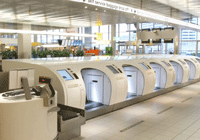 AMSTERDAM AIRPORT SCHIPHOL: BAG DROP
AMSTERDAM AIRPORT SCHIPHOL: BAG DROP
The air terminal ran a trial of the automatic bag drop services back in 2008, in partnership with Air France-KLM. Following a successful pilot run, the technology was rolled out in staggered basis from 2010.
How it works: Instead of heading to a counter to drop off their bags, passengers simply have to scan their boarding passes on a reader. The boarding pass can either be printed on a standard paper or it can be an electronic format saved on a mobile device. Upon reading and confirming all information, the machine prints out an adhesive bag label that passengers need to affix onto their bag handles. Once ready, the machine automatically weighs the suitcase, checks that it is labelled correctly and then sends the bag over the conveyor belt for loading. Finally, the machine will print out a baggage tag for the passenger to keep.
How many: Ten have been installed with another 12 units to be operational by February next year for passengers flying on KLM and SkyTeam partner carriers.
HELSINKI AIRPORT: DOCUMENT CHECK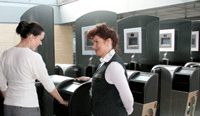
Helsinki Airport, which is a major transit hub between Europe and Asia, has installed electronic border control kiosks to streamline immigration procedures. These are currently available only to European Union citizens, who comprise 60 percent of passengers travelling through the Finnish capital. The electronic border control kiosks considerably reduce the time spent going through immigration at the airport.
How it works: The passenger simply needs to place his or her passport on the electronic biometric reader, which scans the information as well as captures the image on the document.
How many: There are a total of 20 passport check kiosks: ten for passengers entering the Schengen area and ten for those departing.
INCHEON AIRPORT: SELF-BOARDING GATES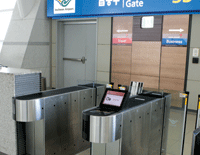
Since 2004, Incheon Airport has been upgrading its operations by rolling out a “U-Airport” framework that seeks to automate almost all passenger touch points. The first part of this framework that was installed was a self check-in service in 2004, and then in 2008, the airport installed electronic biometric boarding gates.
How it works: Passengers scan their passport at the boarding gate, eliminating the need for boarding passes altogether. The machine scans the information and compare it against the passenger manifest to ensure that he or she is on the flight, before the gate opens automatically. The scanner also eliminates manual passport check before boarding is set to commence. The self-boarding gate has a non-proprietary system that can connect to multiple passenger systems used by different airlines
How many: There are several of these automated gates installed at three separate boarding gates at the moment, diminishing the need for queueing up, with more to be rolled out eventually.
MUNICH AIRPORT: INFOGATE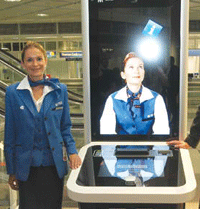
Earlier this year, Munich Airport rolled out an enhanced version of the standard information counter. InfoGate eases navigation and enables passengers to ask questions for more specific help if necessary.
How it works: The Infogate is a large life-size touchscreen that enables users to connect with an information service representative via videoconferencing for a real-time dialogue at times when passengers have specific needs or unique questions. The airport has also installed a second type of InfoGate called the Interactve InfoGate, which has the touchscreen function sans the videoconferencing feature. It is designed to dessminate information about airport services such as shopping and dining.
How many: As of now, six InfoGates and 17 Interactive InfoGates have been implemented.
QANTAS: NEXT-GENERATION CHECK-IN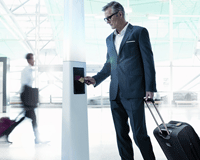
In 2009, Qantas announced it would revolutionise passenger airport experiences with the introduction of its Next-Generation Check-in. The programme replaced all Qantas Frequent Flyer cards – or Q Cards - and luggage tags (Q Bag Tags) with a smart card and a smart permanent baggage tags so that check in, luggage drop and boarding can all be enhanced together. As of now, this service is only available on domestic flights.
How it works: For the smartcards to work, Qantas has installed Q Card readers that use Radio Frequency Identification (RFID) technology, enabling the user to check in just by touching their card on the readers. Once check-in is complete, an SMS is sent to the passenger and the Q Card then doubles up as a boarding pass at both the automatic bag drop kiosks and the boarding gate. At the automatic bag drop counters, users just need to scan their Q Cards and their Q Bag Tags before they can be on their way, therefore eliminating the need for boarding passes and baggage labels altogether.
How many: Currently the services are available at all major domestic airports in Australia, including Perth, Sydney (T3), Melbourne, Brisbane, Adelaide and Canberra as well as 21 other domestic airports. Each airport has a varying number of kiosks.
For an in-depth analysis of the Airports of the Future and what new technologies to expect in the coming years, view our previous coverage here.
This list is not exhaustive and there are other advanced technologies now being used in other airports. Please feel free to add to our list in the comments box below.
Alisha Haridasani








